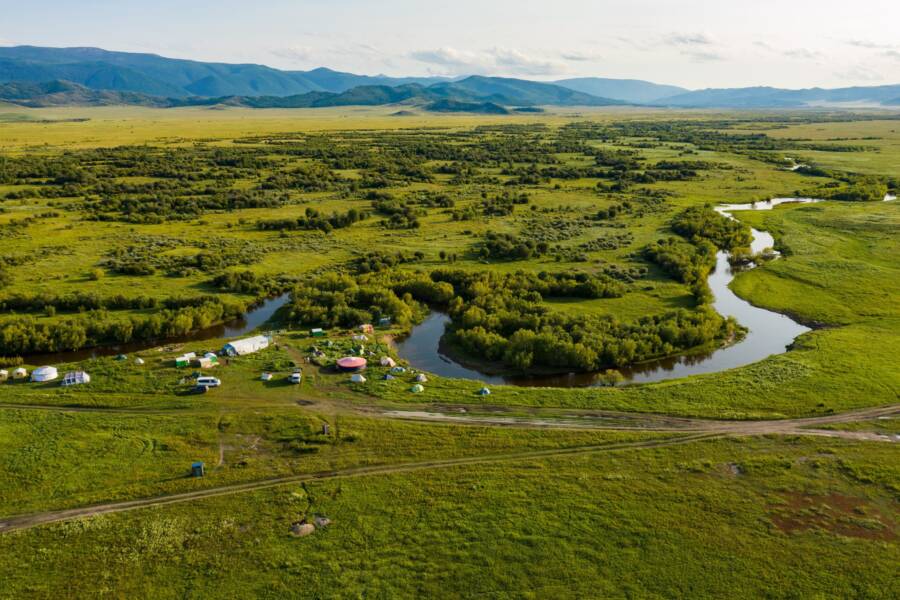The mound discovered in Touran-Uyuk held a number of exquisite gold funerary objects and was constructed by the nomadic Scythian people in the 6th century B.C.E.
Igor PieńkosA woman and young child were among the five body find in Siberia .
Amid the sprawling dark-green vista of the Touran - Uyuk valley in Siberia , a team of Polish and Russian archeologists has made a stunning discovery . There , within the so - called “ Valley of the Kings , ” they ’ve uncovered a sixth - century B.C.E burying mound stop five the great unwashed , include a woman buried with strange honor .
The burial mound , called a kurgan , was in all probability constructed 2,500 old age ago by the Scythians , a mobile mass who migrated west from Asia during the 8th and 7th centuries B.C.E. It ’s one of many mounds in the arena , dubbed the “ Siberian Valley of the Kings ” because of the riches some of them turn back .

Igor PieńkosA woman and young child were among the five bodies found in Siberia.
Still , this barrow stands out . Within its chambers , which were constructedwith wooden beamsas well as planks on the story , the archeologist found five mass . Significantly , one of the chamber held a 50 - yr - erstwhile char entomb alongside a tiddler between two and three year old .
The cleaning woman was buried with several noteworthy grave objective , including aureate ornaments that may have once belonged to a chapeau , an atomic number 26 knife , an engraved cockscomb , and a bronze mirror . What catch archeologist ’ attention , however , was the half - moon pendant .
Igor PieńkosA close up of the stiff showing the golden crescent necklace usually found with male burying ( leave ) and a golden ornament ( right ) .

Igor PieńkosA close up of the remains showing the golden crescent necklace usually found with male burials (left) and a golden ornament (right).
“ A peculiarly interesting artifact was a golden pectoral decoration , a decoration hung at the neck opening in the shape of a sickle or crescent , ” Łukasz Oleszczak , an archaeologist at the Institute of Archaeology at Jagiellonian University in Kraków , who lead the Polish team , toldScience in Poland .
“ They were considered symbol of belong to a social radical , caste , perhaps warriors – in any event , human beings . Its presence in the grave of a woman is a very interesting deviation from this custom . This sure enough confirm the unparalleled role of the at rest in the biotic community of the Valley of the King . ”
Oleszczak also mention that the archaeologists found the woman ’s burial mound just over 200 yards away from another wheelbarrow , which archeologists believe arrest a Scythian boss . “ I think that she was a person of great importance in the society of nomads , ” he explained toLive Science .

Igor PieńkosSiberia’s Touran-Uyuk, where the “Valley of the Kings” is located.
archaeologist also made a number of other breakthrough within the burial mound , which they find using aerial optical maser scans . One chamber appeared to have been looted of its body but still contained weapons and arrows . Another chamber — unlooted — contained a new male warrior , as well as grave object like weapon system and golden ornamentation .
And the 5th body was find just outside the burial chambers in a ditch on the kurgan ’s perimeter . This grave carry a stripling skirt by Harlan F. Stone , a practice which , agree to Oleszczak , was distinctive for Scythian burials .
Igor PieńkosSiberia ’s Touran - Uyuk , where the “ Valley of the Kings ” is place .
“ Stephanie Graf of children on the circumference or just outside the ditch surrounding the garden cart are a distinctive part of the funeral rite of this former Scythian culture , ” he explained toScience in Poland .
Archeologists also found many other object on the border of the burial mound . Using a metallic element demodulator , they uncovered bronze item , including equipment for horses , an ice ax , and an ornament in the shape of a stooge . The archaeologist speculate that these target were break up during the 20th - century when the arena made up part of a collective farm , fit in to LiveScience .
For former Scythians , who were know for being aggressive and mastering hogback riding before many other other cultures , the Touran - Uyuk vale in Siberia seems to have played a significant role . There , these martial people swallow up a number of their dead . Archeologists have even uncover the earliest known Scythian sepulture there , which date stamp to the 8th or ninth hundred B.C.E.
That said , archaeologists have yet to dig up most of the kurgans in the valley in full . The peaceful green fields of Touran - Uyuk in all likelihood hold many more human cadaver and many more funerary target , which can paint a picture of how this ancient polish inhabit , mourn , and died .
After say about the sepulture mound discovered in Siberia ’s Valley of Kings , see why archeologists believe that they ’ve uncover a number ofBritish kings ’ gravesfrom the time of King Arthur . Or , observe the story of thelargest sight child sacrificial website unearthed in Peru .